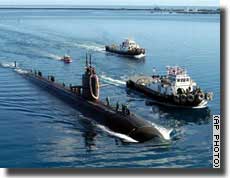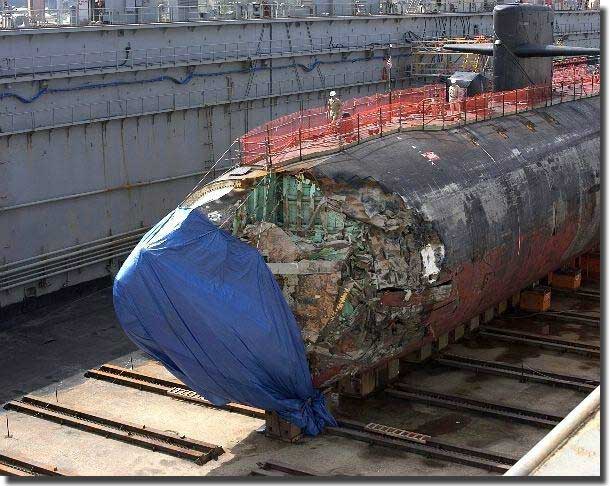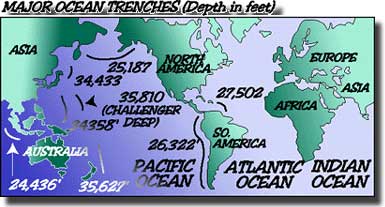en route to Brisbane Australia, for a port visit, came up all standing on Saturday, the 8th. of January 2005, when it ran into an underwater mountain about 350 miles south of Guam. One sailor died and 24 were injured.
Of all the seamounts in the oceans of the world, but .1% have been explored. Seamounts are not well charted on our Navigational charts. Seamounts are not found too often on the charts we use to get us safely to our proposed destination. The Pacific Ocean charts, until recently, carried warnings based on Captain Cook's charts from the 18th. century, and even our more up to date charts are based on soundings that can be 20 miles apart, so huge gaps occur.
A Naval Officer in command, is virtually Master of his Kingdom, he takes all the decisions, most of the kudos when it all goes well, but, if things go awry, he is the bunnie that will face the subsequent music.
It seems to me, when a Naval Officer in command, under any circumstance, grounds that command, in general, he will wind up being relieved of his command, and his career is washed up.
By ROBERT A. HAMILTON
Day Staff Writer, Navy/Defense/Electric Boat
Published on 4/22/2005
A preliminary report on the submarine that hit a seamount in the Pacific
three months ago concludes that numerous warnings of shortcomings in the
ship's navigation department existed at least a year before the accident.
In a January 2004 inspection, the USS San Francisco crew did not
properly use its fathometer warning system and its electronic Voyage
Management System, or VMS, which were both factors in the accident a
year later, according to the report, a copy of which was provided to The
Day.
In August 2004, during another inspection, the San Francisco navigation
team was found deficient in the chart review process, and in a
certification process in October 2004, the team failed to adequately
highlight hazards to navigation on the charts, the report found.
The report outlines a series of weaknesses in the navigation process ––
starting before the San Francisco left port –– that led to the Jan. 8
grounding that killed one crewman and injured almost everyone on board,
29 of them seriously enough to require hospital care.
“The navigation and command teams on SFO (San Francisco) failed to
develop and execute an effective voyage plan that would ensure the safe
and prudent navigation of the ship,” says the Mishap Investigation
Report, as it is known. “This was the fundamental cause of the grounding.”
The report paints a grim picture of the first minutes after the
accident, when the engineer did not recognize the ship had lost almost
all its speed — the speed indicator was stuck on 25 knots as a result of
the crash — and did not take steps to compensate for the reduced
maneuverability of a submarine at slow speeds.
“This could have had drastic consequences,” the report says. “Although
this lack of action in maneuvering did not contribute to the grounding,
it could have resulted in the loss of the ship and crew had the forward
main ballast tanks not held enough air to provide upward momentum.”
Within six seconds of the crash, however, the crew had the submarine in
an “emergency blow,” rising quickly to the surface, but with the bow
down as much as 14 degrees as it climbed 525 feet in less than 90 seconds.
The report provides considerable insight into the damage aboard the
ship, and estimates it will cost $88 million to repair, though it
cautions, “an engineering assessment is in progress that could
substantially change this estimate.”
The report notes that all four torpedo tube doors were deformed and
inoperable; that 15 torpedoes and two Tomahawk missiles had to be
repaired, that the sonar dome was smashed and mostly missing and that
the sonar sphere was breeched, along with three main ballast tanks.
It also lists page after page of other damage, such as computers,
lockers, lights and other equipment that was smashed by men flying
through the air.
The report praised the ship for doing an exceptional job at making sure
equipment was stowed properly before the accidents so loose gear was not
turned into missiles, and for a response to both the mechanical and
medical problems that was very effective.
•••
The report found fault with Submarine Squadron 15 in Guam, where the San
Francisco is based, and with Submarine Group Seven in Yokosuka, Japan,
which oversees Squadron 15.
There has been considerable griping within the submarine community that
that the San Francisco crew has shouldered all the blame while
higher-ups have escaped criticism.
Although the report placed the blame for the accident squarely on the
navigation team and command team on the San Francisco, it found that the
squadron and the group could have done more to prepare the ship for sea.
In particular, the report noted that the squadron “did not take adequate
action to correct previously identified deficiencies in open ocean
navigation onboard SFO,” and did not even require the ship to report
what it was doing to fix the problems.
In addition, the squadron did not provide adequate oversight of the San
Francisco's navigation performance because it was understaffed, with two
positions unfilled, and the squadron assistant navigator was assigned to
one of the other squadron submarines for most of the previous year.
The report also notes the document known as a “Subnote” from the Group,
which laid out a path and average speed, was delivered to the ship
two-and-a-half days before San Francisco sailed, and the Group's own
requirements are that it be to the ship three to five days before sailing.
But the report found the submarine captain spent as much time as he
usually did reviewing the charts, as did other members of the navigation
team, and that the timing of the Subnote did not contribute to the accident.
“Although the ship felt that the late delivery of the Subnote did not
affect the method in which the voyage was planned, reviewed and
approved, that is only because their process lacked the rigor to ensure
such adequate voyage planning was accomplished,” the report concludes.
Capt. Matthew S. Brown, a spokesman for Adm. Walter F. Doran, commander
of the U.S. Pacific Fleet, said the Mishap Investigation Report is an
internal document, intended as a quick review of an accident.
“I'm not going to discuss the contents of a report that is not
releasable,” Brown said. He said the final command investigation will be
out soon, perhaps within another week or two, “that will go into much
greater detail.”
•••
San Francisco left Guam just before 8 a.m. Jan. 7, headed for a liberty
port call in Brisbane, Australia, according to the report, prepared by a
team led by Capt. Kenneth D. Walker, commander of the Pacific Naval
Submarine Training Center, in the weeks immediately after the accident.
At 1:53 a.m. the morning of Jan. 8, the navigation team shifted to chart
E2203, which generally showed water depths of 7,200 to 7,800 feet along
its intended path. But less than five hours later, the ship's fathometer
recorded a depth of 5,610 feet.
From 6 to 7 a.m., the soundings were all about 1,200 feet shallower
than what was shown on the charts. At 7:30 a.m., the ship went to
periscope depth to use the global positioning system to fix its position
on the charts accurately, and submerged again at 9:48 a.m.
At 11 a.m. the fathometer reported 8,652 feet of water; at 11:15, 5,988
feet; at 11:30, just under 6,588 feet.
At 11:43:21 a.m., the San Francisco ran into an underwater mountain at a
speed greater than 25 knots, just as the crew was finishing lunch.
Machinist Mate 2nd Class Joseph Allen Ashley was killed as he was thrown
into a large piece of equipment in the machinery spaces. Dozens of
others were seriously wounded, and “nearly all of the 138 crew members
suffered some sort of injury,” according to the report.
The investigation team faulted the San Francisco for not recognizing the
shoaling water and for not becoming more cautious when the depths that
were showing up on the fathometer did not match what was on the chart.
And it said the submarine should probably have been doing more than one
sounding every 15 minutes — and certainly should have done one when the
submarine changed its depth from 400 to 525 feet at 11:39.
“Had they taken a sounding at this point (four minutes prior to the
grounding) it is likely that the sounding would have indicated a depth
significantly shallower than charted water depth,” the report found.
A more serious problem emerged from a review of the use of charts on the
San Francisco, the investigation found.
“All members of the (San Francisco's) navigation team believed that the
E2202 chart was the best information available and that it was based on
extensive U.S. Navy surveys,” the report found. “This assumption was
invalid.”
In fact, the investigation team said, there was a notation that some of
the features on the chart might be off by as much as three nautical
miles, and the submarine had at least three other charts on board of the
same area that showed an area of “muddy water” that was an indication of
a seamount.
“The only chart on which this report does not appear is E2202, the chart
in use at the time of the grounding,” the report says.
The investigation also found that the navigation team did not understand
the nature of the hazards in the Caroline Island chain, where the
accident occurred. Generally ships are told to use caution within 12
nautical miles of land; the San Francisco team was under the impression
that two miles was sufficient.
•••
San Francisco had one of the most advanced navigation tools available
today in the submarine force, the VMS. Though the system was not
certified as a primary navigation tool, the ship could have programmed
its Subnote into the system.
“Had this been done, the ship would have received a warning, alerting
them to the presence of a navigational hazard along the ship's track,”
the report says.
It found that the failure to use VMS was “the result of a lack of
training, lack of adequate procedures and lack of supervision by both
the internal and external chains of command.”
The report found that the Subnote did route the San Francisco through
the area where it hit the seamount, and it recommends that in the future
the group take more care to route submarines around known navigational
hazards. It also said the Subnote “specifically states that navigational
safety is not provided by the Subnote and rests with the ship.”
“Each member (of the navigation team) had an initial reaction of unease
when viewing the charted transit through the Caroline Islands,” the
report says. “However, each member convinced himself, without careful
assessment of risk and evaluation of possible offsets, that the transit
could be made safely as laid out on their chart.”
“After failing to conduct a proper assessment, the ship was left with a
‘business as usual' attitude exemplified by the CO's comment that he was
operating on a 40 (nautical mile)-wide highway,” it continues.
The investigation also rejected the notion that the average speed laid
out in the Subnote was too high, even though it was higher than the
average in the last 30 Subnotes issued by Group Seven. In fact, at the
time of the grounding, San Francisco was almost 40 miles ahead of where
it had to be, and was going faster than required for operational
considerations.



